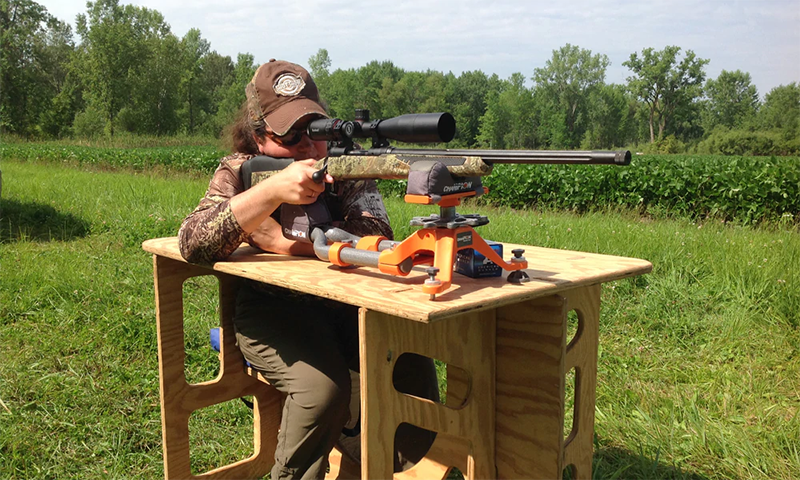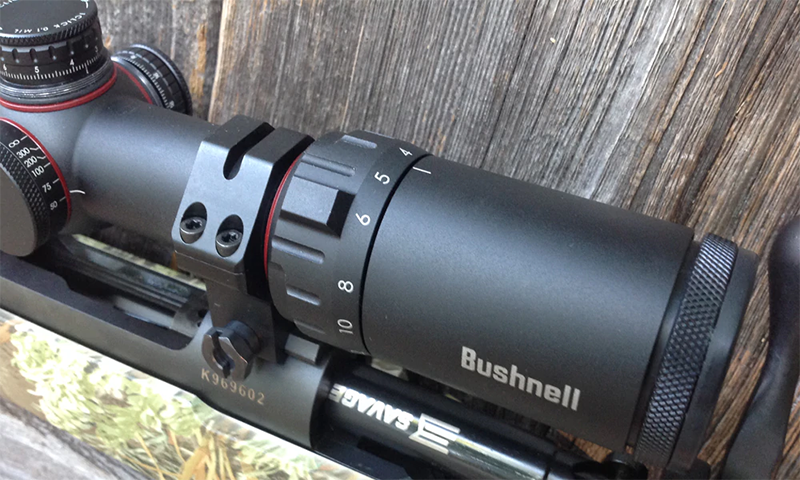HOW TO ZERO A RIFLESCOPE AT 100 YARDS
23rd Aug 2019
Source Credit to guns.com | by GDC Staff
Click here to view the original article.

Zeroing a rifle is best accomplished with a rest. (Photo: Kristin Alberts/Guns.com)
You’ve chosen your riflescope, and whether the rifle is a small caliber or a bigger bore centerfire, the process of zeroing the scope need not be a dreaded one. Even if you intend to shoot long distance, starting with a 100-yard zero is the basis for everything going forward. In fact, with these simple steps, getting that scope dialed in and punching out bullseyes at football field distances is quite simple.
STEP 1: KNOW YOUR RIFLESCOPE
Range time is made much easier when you’re familiar with your riflescope. Take time to learn about the scope itself, as well as the type of reticle. Is it MOA or MIL? That will affect the units of measure to which the scope adjusts as you turn the turrets. How far you adjust depends upon the individual scope, though most clicks will equal one-quarter-inch at 100 yards on the more common civilian MOA riflescopes. Understanding your specific scope’s limits, measurements and functions will ultimately lead to a more efficient time at the range with less frustration.
STEP 2: MOUNT AND LEVEL THE OPTIC

Whether you do this at home or have the local gun shop mount your riflescopes, the importance of mounting details will set the stage for your accuracy and success down the road. In short, don’t speed through this step. Start with quality mounts rather than choosing the cheapest available, especially for larger calibers that will face the shock of heavier recoil.
Ensure that the riflescope is mounted level and also torqued to the correct factory-recommended settings using an appropriate torque wrench. Most shops will do this for you when you purchase the scope.

Understanding the riflescope and its operations will help the zero process. (Photo: Kristin Alberts/Guns.com)
STEP 3: BORESIGHT
After mounting the optic, whether at home or by a gun shop, the next step in the sighting process is to perform a boresighting job. Boresighting simply means that you’re ensuring the scope is aligned with the barrel and iron sights. It’s not only quick and painless, but usually comes included if a shop is mounting the scope for you; however, if you’re DIYing, you’ll need a few simple tools like a laser or manual muzzle insert to complete the task.
This will give you the best start on the range, meaning you’ll most likely ping paper at 50 yards. If you don’t have access to boresighting tools, you can skip this step, but it means you’ll have to start even closer for the next step to save both ammo and frustration.
STEP 4: START CLOSE
Because these will be the first shots since the riflescope has been mounted, it’s best to start close so as to expedite the process. Even the best boresighting job does not guarantee the rifle will be directly on target, especially at 100-yards. 50-yards is the most common distance to begin zeroing the rifle on the range.
Take three shots from a solid rest and assess the target. Make major adjustments at this distance instead of going directly to greater distance. Just remember that if four clicks equal one inch at 100-yards, be aware closer ranges multiply the changes, so in that case, eight clicks would make the same adjustment at 50-yards. Once you’ve got clean groupings on target at 50-yards move on to the final step.
STEP 5: MAKE FINAL ADJUSTMENTS AT 100 YARDS
Now that you know the exact point of impact at 50-yards and are familiar with making adjustments to the optic, it’s time to swing out to the 100-yard target. While many folks claim you can adequately zero with a single shot, there is too much potential for fluke and error. Shoot a three-shot group before making any adjustments.
While practicing as you plan to hunt or shoot is always the best practice, sighting in the rifle from a solid rest so as to remove the human error element is a good starting point. Some hunters, using a simple duplex reticle, will opt to keep that three-shot group an inch or two high at 100 yards instead of shooting dead center in order to better prepare for 200-plus yard shots.

After initial zero is achieved, have fun plinking! (Photo: Guns.com)
STEP 6: HAVE FUN SHOOTING
Once you’re confident with where the rifle—and you—are shooting, you’re all set. Don’t forget though, zeroing the scope is just the beginning. Practice is where everything comes together.
